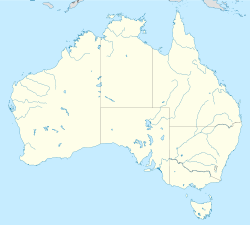- Mount Isa Mines
-
Mount Isa Mines Location Location in Australia 20°42′58″S 139°28′34″E / 20.71611°S 139.47611°ECoordinates: 20°42′58″S 139°28′34″E / 20.71611°S 139.47611°E
Location Mount Isa State Queensland Country Australia Owner Company Xstrata Website http://www.xstrata.com/ Production Products Copper
Zinc
Lead
SilverProduction 470,000 tonnes of Copper History Opened 1923 The Mount Isa copper, lead, zinc and silver mines near Mount Isa, Queensland, Australia are part of the Xstrata mining company.
Contents
History
In 1923 the orebody containing lead, zinc and silver was discovered by the miner John Campbell Miles. The company Mount Isa Mines [2] was founded 1924 but full scale production was not reached before 1931. The lead and zinc mining continued with a break between 1943 and 1946. The copper ore was first discovered in 1927 and production grew steadily with a peak between 1957 and 1965.
Orebodies
Mount Isa contains two separate orebodies: a stratigraphically lower lead-zinc-silver ore horizon and an upper copper ore. Both are contained within the Lower Proterozoic Urquhart Shale. The Urquhart is 1000 metres thick and is a grey dolomitic shale with tuffaceous horizons. Near the ore horizons the shale is pyritic. The orebodies are on one limb of a plunging anticline and are extensively faulted.[1]
The ore occurs as en-echelon bodies parallel to the shale bedding. Orebodies may extend more than one kilometre along strike and three-fourths of a kilometre down dip. Thickness may reach 50 metres.[1]
The ores are considered to be syn-genetic with the host shale and interbedded volcanic material.[1]
Lead zinc silver ore
The primary ore consists of galena, iron rich sphalerite and tetrahedrite as ore minerals along with common accessories pyrite, pyrrhotite, quartz, carbonates and graphite. Minor arsenopyrite, marcasite, chalcopyrite, valleriite, proustite, polybasite and argentite also occur. Original surface oxidized ore contained cerussite, anglesite and pyromorphite. Silver and zinc were removed from the surface oxidized zone and were deposited as supergene ore at a depth above the primary ore.[1]
Copper ore
Copper occurs in brecciated "silica-dolomite" rock. Primary minerals are chalcopyrite, pyrrhotite and arsenopyrite. minor amounts of cobaltite, marcasite, valleriite, chalcostibite, galena and others are reported.[1]
Production
- 5.4 million tonnes copper ore with 3.3% copper (1986)
- 4.6 million tonnes silver-lead-zinc ore wit 154g/t silver 5.4% lead 6,5% zinc (1986)[citation needed]
Smelter operations release sulfur dioxide emissions very close to the city of Mount Isa. The Mount Isa Mines Panel Assessment Study recently spent 4 years investigating the air quality and the effects on community health. The panel found no evidence of adverse effects from the mine. However, the panel did not report on emissions of lead and several other metals associated with sulphur dioxide emissions and which are known to have potentially severe environmental and health effects. Mount Isa Mines is currently the highest atmospheric emitter of sulphur dioxide, lead and several other metals in Australia. Other research has confirmed that there has been widespread contamination of soils with lead, copper and other metals in and around Mount Isa and that these contaminants are derived from both historic and ongoing smelter emissions and fugitive dust from Mount Isa Mines. Queensland Health reported in 2008 that the average blood lead concentration for children (1–4 years old) in Mount Isa was 5 microgram/dL and 11.3% exceeded 10 microgram/dL. In comparison, average blood lead in children from uncontaminated comparable urban areas is around 2 microgram/dL. Recent medical research has documented adverse health effects at blood lead concentrations above 5 microgram/dL and possibly down to as low as 2 microgram/dL.[2][3][4][5]
References
- ^ a b c d e John M. Guilbert and Charles F Park, Jr., THe Geology of Ore Deposits, Freeman, 1986, pp. 667-675 ISBN 0-7167-1456-6
- ^ Final report of Mount Isa Mines Limited Panel Assessment Study. Retrieved 10 Feb 2010.
- ^ MIM Metals Report
- ^ [1] Queensland Health Mt Isa Lead Report
- ^ http://www.npi.gov.au/ National Pollutant Inventory
External links
Wikimedia Foundation. 2010.


